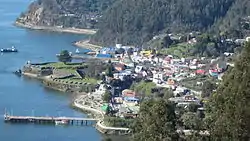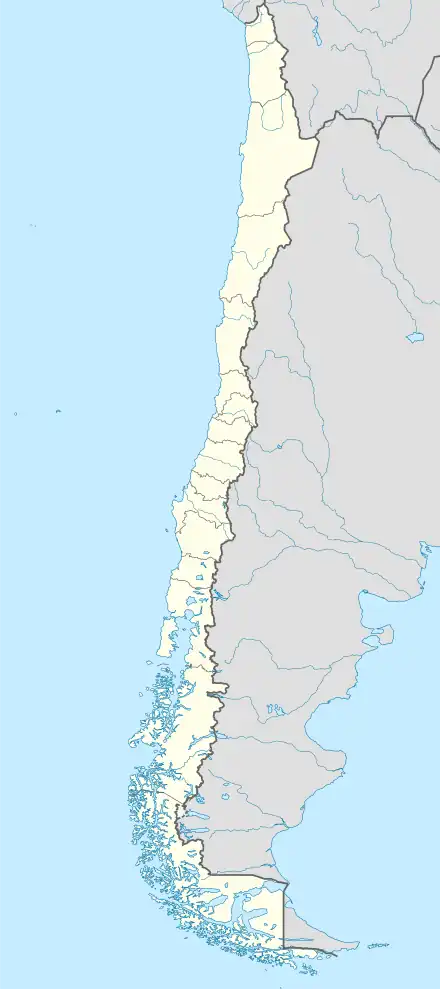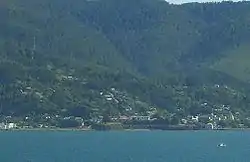Corral | |
|---|---|
 View of Corral from the hills | |
 Flag  Coat of arms  Map of Corral in Los Ríos Region  Corral Location in Chile | |
| Coordinates: 39°53′18″S 73°25′57″W / 39.88833°S 73.43250°W | |
| Country | Chile |
| Region | Los Ríos |
| Province | Valdivia |
| Founded | 1894 |
| Government | |
| • Type | Municipality |
| • Alcalde | Miguel Hernández Mella (ILE) |
| Area | |
| • Total | 766.7 km2 (296.0 sq mi) |
| Elevation | 61 m (200 ft) |
| Population (2012 census)[3] | |
| • Total | 5,084 |
| • Density | 6.6/km2 (17/sq mi) |
| • Urban | 3,670 |
| • Rural | 1,793 |
| Demonym | Corraleño |
| Sex | |
| • Men | 2,864 |
| • Women | 2,599 |
| Time zone | UTC−04:00 (CLT[4]) |
| • Summer (DST) | UTC−03:00 (CLST[5]) |
| Area code | 56 + 63 |
| Climate | Cfb |
| Website | Municipality of Corral |
Corral is a town, commune, and sea port in Valdivia Province, Los Ríos Region, Chile. It is located south of Corral Bay. During the colonial period, Corral was the headquarters of the Valdivian Fort System, which protected Valdivia. Economic activities in Corral revolve around forestry, aquaculture, fishing, port services and both heritage, and eco tourism.
The town is connected by road to Valdivia and Caleta Chaihuín, as well as via ferry to Niebla.
History

The settlement of Corral originated as the headquarters of the Valdivian Fort System, which was built in 1645 to protect the city of Valdivia. At the time, Spanish ships sailed along the Valdivia River to Valdivia, but Corral soon took over the role of receiving major ships. The fort of Corral had no more than four cannons until 1749.[6] Renewed interest in the defense of Valdivia led Juan Zermeño to expand and improve the fort between 1767 and 1773, when work was halted to focus on the battery of Chorocamayo. The renovation was executed by Juan Garland, who extensively modified Zermeño's plans.[6] Indigenous Cuncos, who were at war with the Spanish, had planned to attack Corral in 1770 and had built for that reason a road from Punta Galera to the port, which the Spanish garrison dismantled.[7]
The modern core of Corral grew around the fort Castillo de Corral in the 1770s.[8] By 1798 this settlement outside the fort had a population of 49.[9][8] During the Chilean Independence War, Corral and Valdivia were united with Chiloé as royalist strongholds. In 1820, Thomas Cochrane, commander of the newly created Chilean Navy, captured Corral and Valdivia in an amphibious attack.
Through the early 20th century, Corral was an important port for traffic between the Pacific and the Atlantic Oceans, as Chilean port were declared open to ships sailing under any state flag.
Hydraulic sawmills were built in Corral in 1847–1848.[10]
Decline

Corral's economy experienced a series of events in the 20th century that led its decline. Train routes that connected Valdivia and Osorno to central Chile, as well as the opening of the Panama Canal resulted in the loss of most domestic and international traffic to in Corral.
In 1910, Altos Hornos y Acerías de Corral opened in Corral what was then the largest steel mill in South America.[11] It produced high-cost pig iron using charcoal, and was labour-intensive.[12][13] The steel mill proved to be an economical failure and was finally closed in 1958.
Corral was for a time an important whaling port.[14] The local whaling industry was disrupted for the duration of the First World War, when it was impossible to import needed supplies, but resumed afterwards.[14] Whaling in Chile declined dramatically in the 1960s and ended altogether in 1983.[15] Remnants of whaling infrastructure are still visible on land.[14]
The decline of Corral culminated in 1960 with the Great Chilean Earthquake. With a magnitude of 9.4–9.6, it remains the largest ever recorded. Houses, roads, and port facilities were destroyed. The resulting tsunami obliterated the neighborhood of Corral Bajo and approximately 30% of nearby Corral Alto.[16] Among the losses were a series stilt houses between Corral Bajos and Amargos.[16] After the earthquake many families in corral relocated to the neighborhood of La Aguada.[17] As of 2015, only one pier, privately owned by a local company for the shipping of wood chips, remained.[18] The maximum permissible draught is 12.20 metres.[18]
Demographics
According to the 2002 census of the National Statistics Institute, Corral spans an area of 766.7 km2 (296 sq mi) and has 5,463 inhabitants (2,864 men and 2,599 women). Of these, 3,670 (67.2%) lived in urban areas and 1,793 (32.8%) in rural areas. The population fell by 5.2% (302 persons) between the 1992 and 2002 censuses.[3]
Administration
As a commune, Corral is a third-level administrative division of Chile administered by a municipal council, headed by an alcalde who is directly elected every four years. The 2008–2012 alcalde was Gaston Peréz González (ILE).[1][2]
Within the electoral divisions of Chile, Corral is represented in the Chamber of Deputies by Alfonso De Urresti (PS) and Roberto Delmastro (RN) as part of the 53rd electoral district, together with Valdivia, Lanco, Mariquina and Máfil. The commune is represented in the Senate during the 2014–2022 period by Alfonso de Urresti (PS) and Ena von Baer (UDI) as part of the 16th senatorial constituency (Los Ríos Region).
See also
Notes and references
- 1 2 "Asociación Chilena de Municipalidades" (in Spanish). Archived from the original on 12 May 2015. Retrieved 7 February 2011.
- 1 2 "Municipality of Corral" (in Spanish). Archived from the original on 12 May 2015. Retrieved 7 February 2011.
- 1 2 3 4 "National Statistics Institute" (in Spanish). Archived from the original on 13 November 2010. Retrieved 13 December 2010.
- ↑ "Chile Time". WorldTimeZones.org. Archived from the original on 11 September 2007. Retrieved 29 July 2010.
- ↑ "Chile Summer Time". WorldTimeZones.org. Archived from the original on 11 September 2007. Retrieved 29 July 2010.
- 1 2 Guarda 1953, p. 153.
- ↑ Guarda 1953, p. 155.
- 1 2 Angulo, S.E. (1997). "La Artillería y los Artilleros en Chile. Valdivia y Chiloé como antemural del Pacífico". Militaria: revista de cultura militar, 10, pp. 237-264
- ↑ Guarda 1953, p. 154.
- ↑ Guarda O.S.B., Gabriel (1980). Conjuntos urbanos arquitectónicos Valdivia, ss. XVIII-XIX (in Spanish). Ediciones Nueva Universidad. p. 83.
- ↑ It was the first steel mill in South America and was estimated to cost over two million US dollars. "First Steel Mill in South America". American Machinist. Vol. 32. 14 October 1909. p. 668.
- ↑ Finer, Herman (1947). The Chilean Development Corporation (PDF). Montreal, Canada: International Labour Office. p. 30. Archived from the original (PDF) on 11 August 2015. Retrieved 11 August 2015.
- ↑ CORFO subsidized a reorganization to try to save the facility. Butland, Gilbert J. (1951). Chile : an outline of its geography, economics, and politics. London: Oxford University Press for the Royal Institute of International Affairs. p. 97. The reorganization included an expansion to try to reach production of 29,000 tons a year. Prebisch, Raúl, ed. (1954). Study of the Prospectsof Inter-Latin-American Trade (PDF). New York: United Nations. p. 101. Archived (PDF) from the original on 11 August 2015.
- 1 2 3 "La Industria Ballenera en Corral". oficinadeturismodecorral.jimdofree.com (in Spanish). Comuna de Corral. Archived from the original on 23 April 2021. Retrieved 22 April 2021.
- ↑ Quiroz, Daniel (2015). "Balleneros en la niebla: Una mirada para-etnográfica de la caza de ballenas en Chile" [Whalers in the fog: Para-ethnographic outlook of whaling in Chile]. Chungara (in Spanish). 47 (2). doi:10.4067/S0717-73562015005000025. Archived from the original on 23 April 2021. Retrieved 12 November 2015.
- ↑ Schwerter Langenbach, Carolina; Basso Zapata, Ismael (2010). Reconstrucción de la memoria histórica del barrio La Aguadam1906-2010 (in Spanish). Unidad de Comunicaciones Consejo de la Cultura y las Artes Región de Los Ríos. p. 36.
- 1 2 Ian Taylor & Company (2015). "8.13 Corral". Port Information Chile (PDF). p. 71. Archived from the original (PDF) on 4 March 2016. Retrieved 11 August 2015.
- Bibliography
- Guarda Geywitz, Fernando (1953). Historia de Valdivia (in Spanish). Santiago de Chile: Imprenta Cultura.
External links
- Municipality of Corral (in Spanish)
